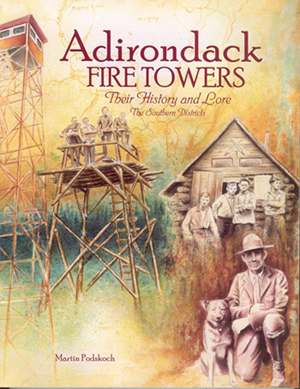Adirondack Fire Towers
Their History and Lore The Southern Districts

Fire towers are an essential element in the history of New York State
having stood for nearly a century as guardians of the vast woodlands in
the Adirondack and Catskill Mountains. While lightning had always been
a threat to the forests, it was not until the late 19th century with the
advent of the railroads serving new communities and expanding tourism
that forest fires became a serious threat to life and property.
Locomotives shot burning cinders and sparks onto the right-of-way starting fires that reached into the forests where loggers had left treetops and limbs, dried out, ready fuel for what became gigantic fires that destroyed thousands of acres, drove people from their homes, and darkened the skies in distant cities. In 1903 and 1908 the destruction was disastrous and the state was spurred by public pressure to create a new, more effective system to contain the rampant flames.
In 1909 the state began to erect primitive outlook stations with observers
on duty throughout the fire season perched atop crude log towers with
open platforms. The observers lived in tents or log cabins nearby. Over
the next decade these lookout stations evolved into metal towers with
enclosed cabs rising as much as 70' above the forest floor. Later standard
cabins were built to provide durable homes and the towers became a preferred
destination for generations of hikers who would climb the towers for the
panoramic views and to listen to the lore of the nature-wise observers.
Marty Podskoch has become the chronicler of the history and lore of the fire towers of the Catskill and Adirondack Mountains. His interest in the subject was aroused in 1987 when he visited the tower on Hunter Mountain. The observer was so enthusiastic about and proud of his work protecting the forests and educating the public on fire prevention that it inspired Marty to learn more about the towers. His research has taken him thousands of miles throughout the mountains of New York visiting the observers, the forest rangers who supervised the towers, and their families and friends as he gathered stories and pictures about their adventures "on the mountain."
Adirondack Fire Towers: Their History and Lore, the Southern Districts published by Purple Mountain Press of Fleischmanns, NY, covers the general history of the state fire prevention system from the late 19th century to the 1980s, when the role of the towers was diminished as air surveillance took over the function of fire spotting at reduced cost. Eventually, all of the towers were closed and many were removed, but recently several communities have restored their towers to be once again an attraction to hikers and a source of knowledge about the region.
Included in the book are many hundreds of human interest stories the author has gathered in personal interviews, and 233 photographs both historical and contemporary that give intimate details of the lives of these courageous denizens of the deep woods. Bears abound! Danger flashes down in lightning bolts that fry telephones and make hair stand on end! Porcupines gnaw everything! Families survive nicely in tiny cabins, and always the towers stand and sway in wind and rain staffed by men and women dedicated to preserving our precious wilderness.
The new book covers 29 state and 3 private towers in the southern part of the Adirondack Park, which includes parts of Herkimer, Lewis, Hamilton, Fulton, Saratoga, Washington, and Warren Counties. Many are still standing and directions and maps are included. The 256-page, large-format book is available in a paperback edition signed by author for $20.00 plus $2.00 shipping and handling .It can be purchased by contacting Adirondacks.com. A future volume will cover fire towers in the northern section of the mountains.
Marty Podskoch is a retired Middle School teacher who was director of a long-standing book fair at Delaware Academy in Delhi, NY, enticing a wide variety of people to spend the day at the school sharing their skills as authors, editors, and writers, with the student body.